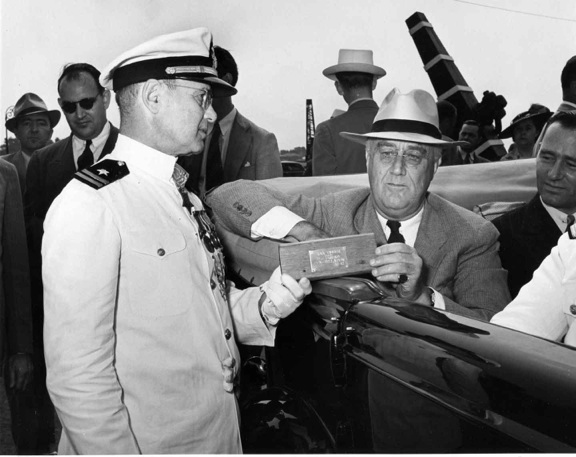Destroyers for Bases

-
FDR on milittary tour
On September 2, 1940 the United States signed an agreement to transfer 50 old destroyers to the United Kingdom in return to the rights to four British bases in the Western Hemisphere.
As the war transformed from a “phony war” to a genuine war on the Western front, Britain’s need for assistance continued to grow. President Roosevelt had no problem selling guns, ammunition, and planes to Britain, (since the U.S. was producing these resources in sufficient numbers). Though, Churchill insisted that his greatest need was for Destroyers to protect British convoys from U-boat attack. Providing Great Britain with Destroyers was a particularly vexing problem for Roosevelt. The U.S. had 200 World War I era destroyers in storage, of which, 176 had just been refurbished and returned to service. Surely the United States could spare 50 ships. However, the most recent appropriations bill included a clause stating that: Arms could only be provided if the chief of the service could assert U.S. Forces did not need them. Since the Chief of Naval Operations had recently testified how vital these destroyer vessels were, to get money to re-outfit them. The Naval Chief clearly could not declare these ships surplus.
A private group came together at the Century Club in New York to come to the rescue. The group warned the nation of the dangers of a German victory and highlighted the urgency to find all possible ways to aid the British. The group included Henry Luce of Time Magazine, as well as the Presidents of Harvard University, and Dartmouth, and many more distinguished Americans. After strategizing, they came up with the idea that the United States could trade bases for Destroyers. Britain agreed, as long as the bases could be leased for 99 years, something that worked well for the U.S. needs. Roosevelt was enthusiastic. However, the question remained whether F.D.R. required Congressional support– something that would take time. Dean Acheson printed a letter on the Editorial page of the New York Times proposing that the President as Commander-in-Chief could take action unilaterally. After consideration, and official approval from the Attorney General, that is precisely what President Roosevelt did. The move was extremely popular. Even the most fervent isolationist could not argue that it was a good deal for the defense of the United States. The eight British bases in the Western Hemisphere that the US received were far more valuable to the U.S. defense than 50 aging destroyers. Yet for Great Britain, the Destroyers were crucial in keeping the sea-lane open in the face of U-Boat attacks.
 >
>